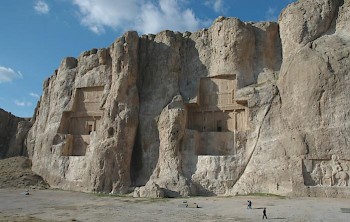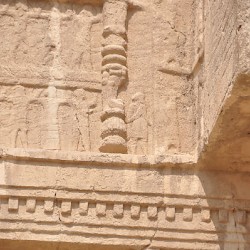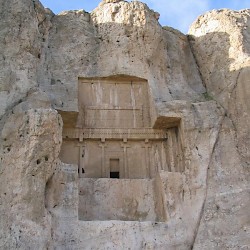Naqš-e Rustam, Achaemenid tomb II
Q71990823Naqš-e Rustam: archaeological site in Fars (Iran), best known for its Achaemenid tombs and rock reliefs made in the Sasanian age.
Tomb II (Artaxerxes I?)

Although Tomb I (left on the photo) and Tomb II (right) have no inscriptions that may help us identify its owners, minor stylistic details allow us to assume that they probably belonged to Darius II Nothus (r.423-404) and to Artaxerxes I Makrocheir (r.465-424). Like Tomb IV, which is generally attributed to king Xerxes (r.486-465), they are almost exact copies of the final resting place of Darius the Great, who, as founder of the Achaemenid dynasty, had set an example for later kings to be followed.
The upper register of Tomb II is therefore identical to the relief of Darius' tomb: the king is standing in front of an altar, praying to the supreme Ahuramazda, and sacrificing to the holy fire. In his right hand, the king has his bow, the royal attribute par excellence. Again, the plaform is carried by people that represent the subject nations. Unlike all other Achaemenid royal tombs, Tomb II has one extra figure.. The symbol in the upper right corner represents the moon.
The Sasanian relief below Tomb II commemorates an equestrian victory by king Hormizd II (r.303-309).
 Naqš-e Rustam, Achaemenid Tomb II |
 Naqš-e Rustam, Achaemenid Tomb II, Relief, Additional figure |
 Naqš-e Rustam, Achaemenid Tomb II, General view |
Literature
Louis Vanden Berghe, Reliefs rupestres de l' Iran ancien (1983 Brussels), #24.